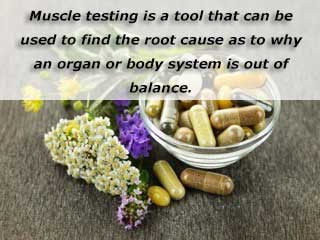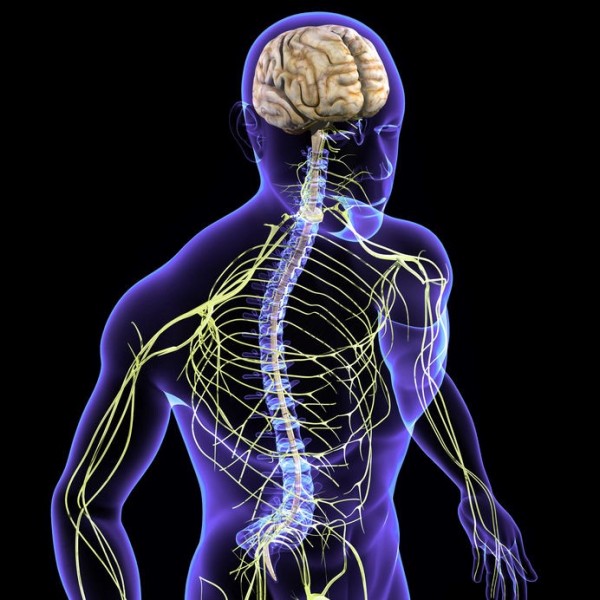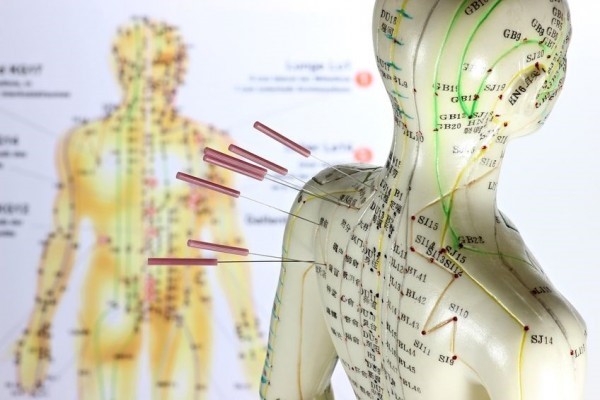Muscle Testing for Chronic Pain
Reviewed by: Marty Johnson, DHM. Owner of Total Health Nutrition Center a Natural Health Clinic in Wisconsin which uses Muscle Testing.

 Muscle Testing also referred to as kinesiology or biomechanics, is the study of body movement or more specifically muscle movement. It is a method of diagnosis and treatment based on the concept of various muscles being linked to particular organs and glands, and that specific muscle weakness can signal distant internal problems such as nerve damage, reduced blood supply, chemical imbalances or toxicity, or other organ or gland problems. (WEIL).
Muscle Testing also referred to as kinesiology or biomechanics, is the study of body movement or more specifically muscle movement. It is a method of diagnosis and treatment based on the concept of various muscles being linked to particular organs and glands, and that specific muscle weakness can signal distant internal problems such as nerve damage, reduced blood supply, chemical imbalances or toxicity, or other organ or gland problems. (WEIL).
Muscle testing is a tool that can be used to find the root cause as to why an organ or body system is out of balance, whether it’s dietary, a nutritional deficiency, nerve tissue damage, or a chemical imbalance. Practitioners find the areas of the body that create muscle weaknesses, and then correct those weaknesses by providing supplements and dietary changes. Once the problem with the associated internal organ is resolved, the body will have the ability to heal itself, and the muscle will no longer be weak. Muscle Testing can help to some degree with any chronic illness.
“By removing the interference in the body, the body has the innate ability to heal itself.”
– Marty Johnson, DHM, Owner of Total Health Nutrition Center
 It is often called the master regulator of metabolism because it controls all the involuntary activities of the body that you do not consciously control. This includes; heart rate, digesting, breathing, tissue repair and rebuilding, regulation of your body temperature, and various other functions. Once the autonomic nervous system is rebalanced and improved, many physical aspects of health have a corresponding improvement. (Total Health Nutrition Center, 2018)
It is often called the master regulator of metabolism because it controls all the involuntary activities of the body that you do not consciously control. This includes; heart rate, digesting, breathing, tissue repair and rebuilding, regulation of your body temperature, and various other functions. Once the autonomic nervous system is rebalanced and improved, many physical aspects of health have a corresponding improvement. (Total Health Nutrition Center, 2018)
The body contains an electrical network or grid, that is pure energy. If you have taken a biology class you’ve learned that all communication in the body occurs from chemical and electrical impulses through normal cellular function. These impulses travel from cell to cell using the network of the central nervous system. If you’ve had an ECG or EKG you have seen proof of this. Since energy runs through the muscles in our body, if something impacts your electrical system that throws off the body’s balance, your muscles will actually “short circuit” or weaken temporarily. Things that can impact your electrical system include; thoughts, emotions, foods, and other substances.
Muscle testing is a way of using those muscles to find out what things are weakening and strengthening the body. Practitioners can actually ask your body questions and get answers. Practitioners are able to check the function of every major organ in the body because of the electrical activity. Without these electrical impulses your body would shut down.
The practitioner will have you extend your arm straight in the air, while standing or while lying down. They will then will apply a small amount of pressure right below your wrist while placing their hand over various organs in your body such as the kidney, liver, or heart. You should be able to keep your arm still, even when a small amount of pressure is applied. If your extended arm does move this will indicate a problem.
When adding just a small number of external stimuli over an organ that is not functioning properly, the body will re-route electrical impulses controlling the extended arm, causing the extended arm to noticeably move. One way of explaining this concept is to think about the fuse box in your home. Adding just a small number of external stimuli to an already stressed organ, causes the arm to give out, just like a fuse being blown. (Total Health Nutrition Center, 2018).
 Muscle testing is also used when suggesting the proper supplements. The practitioner can place the supplements in your hand and apply pressure to your arm to see if it moves or stays strong, determining if that’s the treatment your body needs. The practitioner can also figure out the exact dosage by placing one pill in your hand at a time, checking the muscle response, and then adding one more each time, until your arm moves to indicate when the dosage is too high.
Muscle testing is also used when suggesting the proper supplements. The practitioner can place the supplements in your hand and apply pressure to your arm to see if it moves or stays strong, determining if that’s the treatment your body needs. The practitioner can also figure out the exact dosage by placing one pill in your hand at a time, checking the muscle response, and then adding one more each time, until your arm moves to indicate when the dosage is too high.
 Marty Johnson, DHM, from Total Health Nutrition Center says: “It’s important to understand, anything can cause anything. There are no typical patterns. Any system can cause pain anywhere in the body.”
Marty Johnson, DHM, from Total Health Nutrition Center says: “It’s important to understand, anything can cause anything. There are no typical patterns. Any system can cause pain anywhere in the body.”
So, even though your pain maybe in your head that doesn’t mean the problems are in your head. It could be a completely different part of your body that isn’t functioning right. This is why so many medical doctors struggle to find the root cause of chronic pain. They have no way of finding where the actual problem is, and have only been taught how to treat the symptoms, instead of searching for the cause. This is one of the many reasons why muscle testing is a great place to start finding the problems causing your chronic illness.
Muscle testing can be beneficial for almost any chronic illness, and even help with injuries and learning disabilities. For example, some injuries may not be healing right due to metal toxicities. Muscle testing practitioners can suggest natural supplements to remove the metals, which can help with the healing process. This has also been seen with learning disabilities, such as heavy metals like mercury in an Autistic child. Of course, this hasn’t been the only problem.
 Just about every chronic illness is a result of a part of your body not functioning optimally (examples: kidney, liver, nervous system), along with chemical or other imbalances, allergies, metals, mold, or other toxins in your body. Diet and exercise play a role too, but it is often not the only problem or solution. With many chronic illnesses, there is often more than just one thing wrong. Muscle testing has the ability to find all of these types of problems. However, it will frequently happen in layers due to certain problems covering up other problems. At first the practitioner may find just one thing wrong. Then once the body has time to heal that problem, the doctor may retest you and find other problems that need to be addressed.
Just about every chronic illness is a result of a part of your body not functioning optimally (examples: kidney, liver, nervous system), along with chemical or other imbalances, allergies, metals, mold, or other toxins in your body. Diet and exercise play a role too, but it is often not the only problem or solution. With many chronic illnesses, there is often more than just one thing wrong. Muscle testing has the ability to find all of these types of problems. However, it will frequently happen in layers due to certain problems covering up other problems. At first the practitioner may find just one thing wrong. Then once the body has time to heal that problem, the doctor may retest you and find other problems that need to be addressed.
Muscle testing and Neurofeedback together have been very powerful at addressing the causes of depression. An example of this, is by itself neurofeedback was ineffective due to metals built-up in a person’s brain, so muscle testing helped in treating that problem first, and then the brainwaves were examined again with neurofeedback. Depression can be caused by irregular brainwaves, toxins in the body, chemical imbalances, or deficiencies.
Muscle testing can also help find and address problems causing cancer. For example, a muscle testing practitioner found cancer in someone’s body by using muscle testing to find the area of their body that was stressed. In order to check the accuracy, a person still went into a medical doctor to have a test done, and the results came back positive for cancer. The practitioner then was able to use muscle testing to provide supplements to fix the imbalances which allowed the person’s body to take care of the cancer on its own. A person with progressive breast cancer went to see a medical doctor to find the cancer in their body, but used muscle testing to find the cause and was treated with supplements and dietary changes. They never did chemotherapy. A year later, the test results came back positive that they were cancer free.
 Addressing Food Allergies
Addressing Food AllergiesA severe allergy to something like gluten, means the gut isn’t functioning properly. This can be due to toxins in the body that prevent proper digestion. As the body removes those toxins, through the proper supplements, the person’s gluten sensitivity may greatly diminish or even disappear completely.
It’s important to understand that a diagnosis like this one, doesn’t define the problem with a person’s body. Not everyone diagnosed with fibromyalgia has the same things wrong with their body, just because symptoms are similar. Muscle testing practitioners do not use these labels to diagnose and treat the problems with your body. The label doesn’t help them to find the source of the problem. Instead, they get an understanding of your exact symptoms, and then search for the imbalances in your body.
Health Conditions It Could Help with Include: Abdominal pain, Allergies, Anxiety, Cancer, Depression, Diabetes, Disabilities, Headaches, Fibromyalgia, Learning Disabilities, Osteoporosis, Parkinson’s Disease, Trauma, Vertigo, and many other health problems. This is not a complete list. IT CAN HELP WITH BASCIALLY ANY CHRONIC ILLNESS BY FINDING THE SOURCE OF THE PROBLEM.
A lot of the treatments provided through muscle testing won't produce immediate results. It takes time for the body to heal, and the longer you've had that illness or problem, the longer it takes to heal. The supplements that are prescribed are natural and approved by your body, so side effects if any, are rare. It's also a matter of having a well-trained and experienced practitioner who knows what they are doing.
 He also found that these muscles were linked to acupuncture meridians. In addition, he discovered that the muscles could be strengthened by finding the right vitamins or supplements. On the other side of the coin, he discovered those same muscles would go weak when exposed to unfavorable stimuli. This determined that the body can actually tell what is considered good and bad for it.
He also found that these muscles were linked to acupuncture meridians. In addition, he discovered that the muscles could be strengthened by finding the right vitamins or supplements. On the other side of the coin, he discovered those same muscles would go weak when exposed to unfavorable stimuli. This determined that the body can actually tell what is considered good and bad for it.
In 1968, Dr. Alan Beardall, also a chiropractor, became Dr. Goodheart’s student. He contributed over 250 specific muscle tests to diagnose and evaluate chemical, structural, and mental aspects of health. In 1983, Dr. Beardall found particular hand positions could change the body’s response to the muscle test. This led to a method of diagnosing deeper, more underlying imbalances in the body’s energy patterns.
You can view some studies on the Kinesiology Network and NCBI.
A recent study published in the International Journal of Neuroscience (Vol. 96 pp237-244) reports on the effectiveness of testing for allergic responses to various substances. It showed a success rate of 90.5%.
Practitioners can be found through the International College of Applied Kinesiology website.
To find a practitioner near you, you can also look for a Naturopathic Physicians and call to see if they use muscle testing.
A good muscle testing practitioner will look at your overall health taking into account exercise, nutrition, and stress. They will often give you advice on how to improve your diet, and eliminate consumption of chemicals which is very important in improving your chronic pain condition. Some practitioners can also supply lab tests for things like metals testing, or checking hormone imbalances when answers can’t be found directly through muscle testing alone. With many chronic illnesses, there is often more than just one thing wrong. So, a good practitioner will also help determine if there is a treatment to seek outside of muscle testing to fix the problems with your body.
Then, they will have studied applied kinesiology as a postgraduate usually through weekend classes. The basic courses require over 100 hours of classroom study, plus practice at home. Once they pass, they have to take even more classes with over 300 hours of classroom study. In addition to, writing two research papers in order to pass a diplomate exam (written and oral test) showing a complete understanding of applied kinesiology. Applied Kinesiology is being taught in Europe, Canada, the United States, and Australia, through the International College of Applied Kinesiology.
The time it takes for your body to be healed, will depend on how long you have had problems. It may take a month or more before you start to see the changes. So you will have to be patient, and give it some time.
A visit begins with a detailed medical history. Then, the practitioner will determine changes in blood pressure from lying down, sitting, and standing, this can show imbalances in the body. Next are examinations of skin sensitivity, reflexes, and balance. Practitioners may also examine a patient’s posture, gait, and range of motion. Once those tests are complete, muscle strength is tested by the practitioner. Then, the body is examined using muscle testing for areas not working correctly, possible toxicities in the body, and so on.
Johnson, Marty, DHM. (2018, January 5). Total Health Nutrition Center. Personal interview.
Weil, Andrew, M.D. WEIL/Applied Kinesiology. Retrieved from:
https://www.drweil.com/health-wellness/balanced-living/wellness-therapies/applied-kinesiology/
Scher, Amy B. Amy b. Scher/Muscle Testing: Getting Answers From the Subconscious Mind. Retrieved from: http://amybscher.com/getting-answers-from-the-subsconscious-mind/
Healing-with EFT/Muscle Testing and History of Kinesiology. Retrieved from:
http://www.healing-with-eft.com/history-of-kinesiology.html
Beardall, Christopher. (2015, June 19th). Clinical Kinesiology/The History of Clinical Kinesiology. Retrieved from: https://www.clinicalkinesiology.com/blogs/news/18737025-the-history-of-clinical-kinesiology
Conners Clinic/Applied Kinesiology. Retrieved from: http://upperroomwellness.com/testing/applied-kinesiology--ak-.html